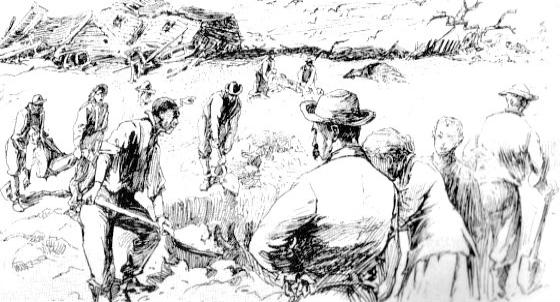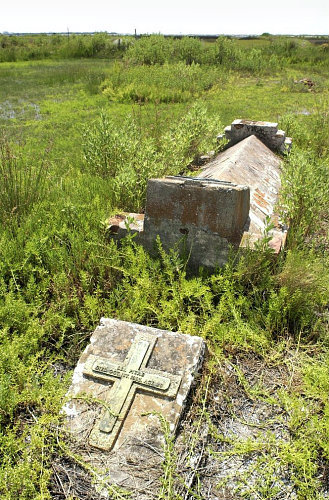
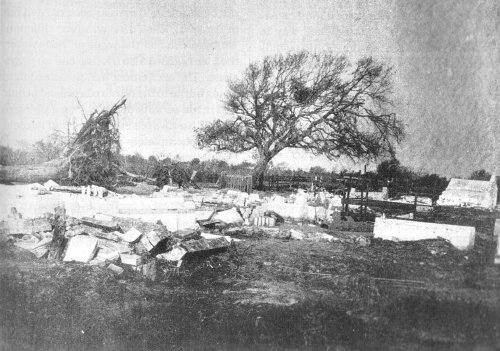
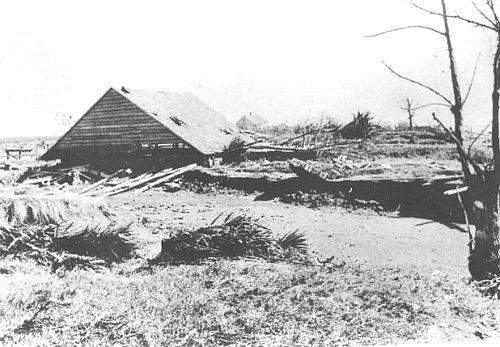
| Cheniere Caminada |
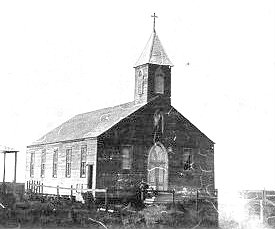
| Cheniere Caminada Cemetery. |
| Seldom mentioned and little remembered, the Great October Storm of 1893 remains, to this day, ranked third in U.S. history in number of lives lost in a hurricane, exceeded only by the 1900 Galveston storm and Katrina and the resulting levee failures in New Orleans in 2005. |
| Of the more than 400 buildings on the island, only 4 were standing after the storm; of the scores of fishing boats, only one remained. |
| Caminada is an island or "cheniere" (ridge) situated next to Grand Isle, off Louisiana's coast, about 65 miles south of New Orleans. When night settled over the Cheniere on October 1, 1893, approximately 1,500 people huddled in their homes, seeking shelter from a sudden storm. |
| By the time daybreak came, more than half of the island's adults and almost all of the children - nearly 800 people - had perished and all but a few of the homes and businesses had been washed away. The historic farming and fishing community of Cheniere Caminada was no more. |
| The dead of Cheniere Caminada suffered the same fate as the living, tombstones and graves had been upended and many washed away. The survivors buried the casualties of the storm - their families - in long trenches, before taking on the task of re-burying the cemetery's dead. Above, Cheniere Caminada Cemetery after the storm; below, a sketch: burying the storm victims. |
| After spending the first day rescuing as many survivors as possible, the captain of the only boat still sea-worthy set out for New Orleans to inform people of the devastation and to seek food, water, medical supplies and doctors. Response was immediate and rescue boats laden with supplies and volunteers started heading down river to the island of Cheniere Caminada. |
| Cheniere's parish priest, Father Grimeaux, survived the storm, the presbytery being one of the few buildings to withstand the night's fury. He gave an account describing his experience, which appeared in the New Orleans Picayune newspaper on October 6, 1893. Below are some excerpts. |
| "The wind and waves shook the frail habitations, which rocked and groaned under the repeated attacks. Soon, houses were being wrecked and carried away. I was in the upper story of the presbytery, holding on to the sill of an open window, hearing the cries of agony of my dying parishoners, powerless to do anything. |
| Cheniere Caminada's Our Lady of Lourdes Church, pictured above, was destroyed by the storm. Survivors spoke of the church's bell, clanging furiously and relentlessly as it was knocked about by the strong winds. This went on for hours and, then, finally, it was silent and those who were left on the island knew the church was gone. |
| "The seething waters flowed madly on and I could see amidst the wreckage and the seaweed a number of bodies floating on and on out of view. I could not count them. It seemed to me like an endless, ghastly procession of spectres. |
| "I leaned forward and, holding up my hands over the waste of waters, I offered a fervent prayer to the Father of all and begged of Him to be merciful in His judgment on the souls of so many of His children who were at that moment dying in a terrible manner. |
| "All around me I could see desolation, death and ruin. Houses floated by and the church soon followed. I never dreamed that I would live through the night. |
| "The population of Cheniere Caminada island is 1471. Of these, only 696 are now living; 779 are dead. Historic Cheniere Caminada is no more." |
| Neither the church or the rest of the Caminada community was rebuilt. The surviving inhabitants moved to nearby places like Leeville, Westwego, Cut-Off or the village of Cote Blanche, which was founded after the storm. Today, only a few fishing camps and scattered tombstones in the ancient cemetery can be found on Cheniere Caminada. |
| My thanks to Larie Tedesco for suggesting that I create a web page about the Cheniere Caminada hurricane. |
| The church bell that tolled through the storm now rests in the bell tower of Lady of the Isle Catholic Church on Grand Isle. I can't help wondering if the residents of Grand Isle, when summoned by the bell on Sunday mornings, ever think of the people of Cheniere Caminada and that fateful date in 1893, when the bell tolled all night long. -- Nancy |
| The photo of Our Lady of Lourdes Church is thanks to Loyola University's Kate Chopin web page. One of the photos is thanks to NOLA.com and one of the photos is from the excellent book, "The Cheniere Caminada Story," which was published on the occasion of the Cheniere Hurricane Centennial in 1993. |
| This book can be purchased here at Amazon.com and I would highly recommend it for anyone who has an interest in the Cheniere Hurricane. |
| Photo Credits: |
| The link to this page is: http://Old-New-Orleans.com/NO_Cheniere_Caminada.html Back to Old New Orleans Whispers - Home |
